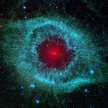Engaging Questions About the Universe and Life
10 Questions with answers that may surprise you.

British spelling
The information contained in my articles has been gained by reading many books on the subject.
I won’t pretend to be an expert, but I hope you will find some of them interesting and educational.
<><><>
Questions 1/10
1: How much of our DNA, "deoxyribonucleic acid," do we share with a slug?
<><><>
2: How big is the sun compared to our planet Earth?
<><><>
3: How far is the Moon travelling away from the Earth each year?
<><><>
4: How long have modern humans existed?
<><><>
5: Can a dog see the colour red?
<><><>
6: If the Earth were a smooth sphere, how deep would the water be?
<><><>
7: How far away is Proxima Centauri, the sun's closest star neighbour?
<><><>
8: How many stars are there in our galaxy, the Milky Way?
<><><>
9: How many atoms make up a human adult body?
<><><>
10: How far up from the surface of the Earth does outer space begin?

Answer 1
You and I share 99.9% of our DNA; the missing 0.1% is what makes us that little bit unique. In the animal kingdom, our closest living relatives are chimpanzees; they share around 99% of our DNA.
Surprisingly, we share 70% of our DNA with slugs. Yes, every living thing on our planet is related to some degree.
Evolutionary biologists agree that all living species are descended from bacteria-like ancestors that lived on our planet over 3.5 billion years ago.
Yes, evolution is amazing, but it is a slow process that takes long periods of time.
<><><>
Answer 2
The Sun is 109 times wider than the Earth.
That may seem very big to us, but our local star, the Sun, is minuscule compared to hypergiant stars.
One of the largest stars known is UY Scuti, with a diameter 1,700 times larger than the Sun.
Now imagine this.
If UY Scuti took the place of the sun, its surface would be beyond the orbit of Jupiter.
Mercury, Venus, Earth, Mars, and Jupiter would all be inside that massive star.
<><><>
Answer 3
It is thought that the Moon formed about 4.5 billion years ago and was much closer to the Earth back then.
At this time, the moon is moving away from the Earth by 3.8 centimetres, or 1.5 inches, each year.
It may seem like a minuscule distance, but in millions or billions of years, the distance between the moon and the earth will substantially increase.
There will come a time when the moon will be so far away from the Earth that a total solar eclipse will be impossible. The moon will be visibly too small in the sky to cover all of the sun.
<><><>
Answer 4
Modern humans originated in Africa and have been around for roughly 200,000 years.
It is thought we evolved from the extinct species Homo erectus (upright man). The first primates existed 55 million years ago.
Evolution is amazing. For me, it is the only plausible reason for our existence.
I wonder how many years it will be before we, as a species, become extinct.
<><><>
Answer 5
No, a dog cannot see red; a red apple would look dark brownish-grey or black to a dog.
We call it colour blindness, the reason being that dogs have only two types of colour receptors, called cones, in their eyes.
Humans have three types of cones; the extra one that we have detects red. This may come as a surprise, but colours don't exist.
Our eyes and our brains present us with spectacular colours, but surprisingly, everything in the universe is colourless.
<><><>
Answer 6
If the Earth were a smooth sphere, there would be no dry ground, and the water all around the Earth would be roughly 2.7 kilometres deep.
But, of course, our planet has high mountains and deep troughs, which is just as well, or we land dwellers would not exist.
All of the Earth's water covers just over 70% of its surface.
The Earth holds an unimaginable amount of water; even the atmosphere contains an estimated 12,900 cubic kilometres or 3,100 cubic miles of water.
<><><>
Answer 7
The closest star to the Sun is Proxima Centauri which is just over 4 light-years away; that distance works out at roughly 40 trillion kilometres.
A trillion is 1 followed by 12 zeros.
Astronomers use the speed of light as a measure of distance. Light travels at almost 300,000 kilometres in one second - that is, 1,080 million kilometres in one hour.
<><><>
Answer 8
A lower estimate for the number of stars in our galaxy, the Milky Way, is 100 billion, but a higher estimate puts the number of stars at an incredible 200 billion.
Can you imagine, in total, the number of planets there must be circling most of those stars?
Our local star, the Sun, has eight orbiting planets.
In our galaxy alone, there must be billions of planets orbiting stars in the Goldilocks zone, which is an area warm enough for liquid water to be in three states: solid, liquid, and gas.
Liquid water is a requirement for the existence of all life as we know it.
<><><>
Answer 9
Roughly seven octillion atoms make up a human adult body.
An octillion is 1 followed by 27 zeros.
Atoms are manufactured in stars, and at the time of supernova explosions, when larger stars than the Sun come to the end of their lives.
Atoms are billions of years old, and the oldest and most common atom in the universe is hydrogen, which is also the simplest and lightest.
<><><>
Answer 10
Outer space begins 100 kilometres, or 62 miles, up from the surface of the Earth; that imaginary boundary is known as the Karman line.
Most of the Earth's atmosphere is below the Karman line, but there is a small percentage of the atmosphere above, which gets less the farther up you go.
The International Space Station orbits the Earth at a distance of 400 kilometres, or 248 miles, from its surface.
The end.
<><><>
You may find my easy-to-understand stories about the universe and life interesting and educational.
If you subscribe to me for free, you will see my latest stories. Regards.
About the Creator
A B Forbes
Someone with a lifelong passion for that gargantuan area we call the universe. I also write stories about life itself. Enjoy






Comments (2)
Wonderful informative article
Outstanding! story,